Two years ago, we had taken a tour of the capitol building (read about the tour) but the dome had been closed for renovations. But it was finally open again and so off we went to see it.

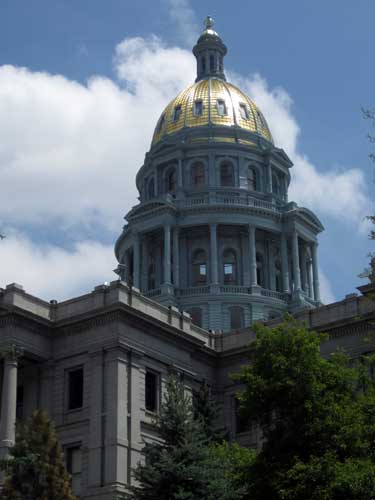
The dome in 2013 and in 2015
The dome was closed in 2006 when a chunk of cast iron fell on the observation deck. Restoration began in 2010 with a 210-foot high and 350,000-pound scaffolding. The curtain (or scrim) around it could handle sustained winds of up to 60 mph, and when heated, it acted like shrink-wrap, making it even stronger.
The total cost of repairs was $17 million. About $4 million came from the city (aka tax payers) but the rest came from grants and donations. 65 ounces of gold (from the Cripple Creek & Victor Gold Mining Co... the same mine that produced the original covering) was spread 1/8000 of a millimeter thick.
The original dome, completed in 1898, was covered in copper. Unfortunately after about 10 years, it turned an ugly green-black color. So they covered the copper plates with thin gold leaf. The dome has been regilded three other times... in 1949, 1980 and 1991. This time, they also replaced the copper as well. Dome gold has a lifespan of about 30 years, mostly due to our harsh weather (especially hail).

Our destination... the observation deck! More than 140,000 sheets of gold leaf were used in the repair. Supposedly there are special gutters up top to catch any gold pieces that wash off.

The very very top part of the dome is called the lantern. It is basically designed for heat to escape. In the original drawings, the lantern was supposed to be crowned with a 12-foot tall statue of a woman. But no one could agree on the design, so instead they just made a crystal sphere. During the recent renovations, however, it was discovered that two of the 16 panels needed to be replaced. But modern-day crystal manufacturers couldn’t replicate the curved panels. So now it simply has 14 crystal panels and 2 glass ones.
We followed the signs and entered through the basement where we were faced with a security check point. I had forgotten that many government buildings have these and had failed to leave the small pocketknife that is always in my purse in the car. Fortunately they were very nice about it. They took the knife and gave me a receipt to reclaim it when I left.
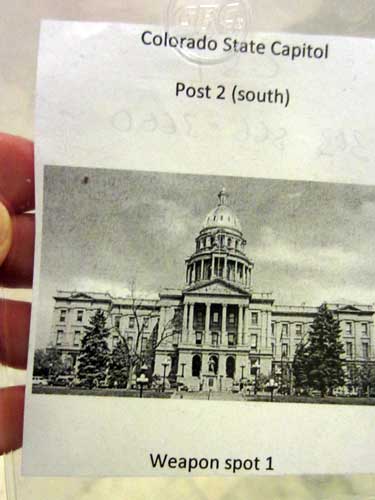
We asked at the info desk about the dome tour. There was some confusion at first and we were directed to the regular building tour. But eventually it all got sorted out and we were told to walk up to the attic where we would be let in through a door to the dome, upon which we could just wander around on our own.

The beautiful first floor

The various symbols of the state
We walked up the large staircases to the attic where a man sat in front of a small door. Apparently they had already called ahead from downstairs so he was expecting us. He let us in and closed the door behind us. This staircase was FAR different than the ones we had just climbed. It felt exciting and adventurous, like we were somehow sneaking in the back way!

The stairs to the dome. In spite of how 'antiquated' these stairs may seem, they are actually new, as part of the renovation.

The backsides of windows

At the top of the stairs, we entered the dome and were allowed to wander around as much as we liked, both inside and out.

Just below us was a ring of stained glass windows of prominent Colorado figures.

Each person is encircled with Rocky Mountain Columbines, our state flower.

Info signs lined the railing.
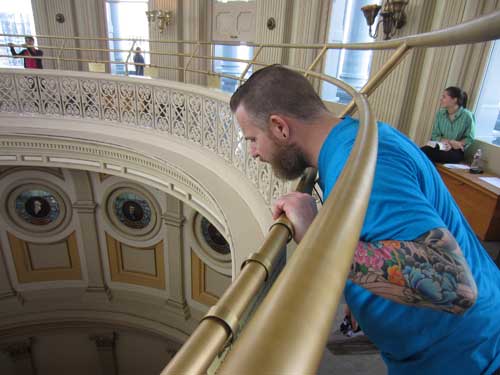
Looking down...

... a loooooong way!

Looking up at the dome, 180 feet up
There are actually TWO domes here.. there’s the gold one we saw from the outside and the rotunda one we see here from the inside. There is actually a space between the two where workers can stand (but simple tourists like us aren't allowed up).

In the very center is a flower.

The first of three staircases that lead up to the lantern.

The stairs were built in 1896 by J. G. Wagner Iron Works.

Some of the lamps were polished...

... while others were not
Sixteen famous figures of Colorado history:

Christopher "Kit" Carson - fighter, soldier, fur trapper and guide for early pioneers and explorers; he became a symbol of the American West

James William Denver: governor of Kansas; federal commissioner on Indian Affairs, only visited Colorado a few times but managed to get a whole city named after him
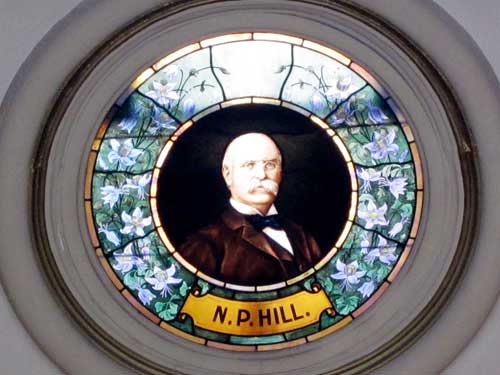
Nathaniel Hill - a chemist who opened several smelting operations; was a US Senator from 1879 - 1885

Casimiro Barela - served in Colorado's state legislature for 25 years; was an advocate for Spanish-speaking settlers and revered as one of Colorado's best livestock men
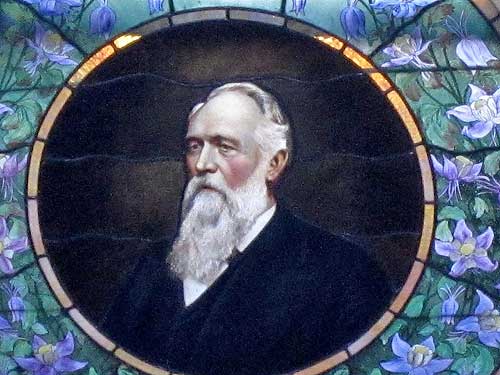
Alexander Majors - owned successful freight companies that transported goods along pioneer roads; also a co-founder of the Pony Express

Frances Wisebart Jacobs- prominent in charity organizations; founded the state's first free kindergarten and also the United Way

William Gilpin - first governor of the Territory of Colorado from 1861 - 1862; explorer, military officer and politician

John Evans - second governor of the Territory of Colorado in 1862; was forced to resign after the Sand Creek Massacre; was founder of the University of Denver

William Byers - US deputy surveyor; founded the Rocky Mountain News which ran from 1859 - 2009

Chief Ouray - chief of the Uncompahgre tribe of the Ute Nation; negotiated treaties (that were later broken and the tribe was relocated to Utah)

General William Palmer - railroad builder, including the Denver and Rio Grand Railroad (the first narrow gauge railway in the US); founded Colorado Springs

John Dyer - a Methodist minister who preached in the mining camps; even snowshoed through the mountains to spread his message which earned him the nickname "the snowshoe itinerant"
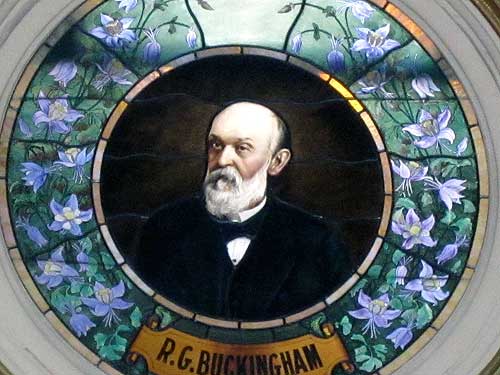
Richard Buckingham - doctor, politician; helped found the Colorado School for the Deaf and the Blind and also the Denver Medical Association; was 13th mayor of Denver

General Bela M. Hughes: businessman and politician; first president of the Denver Pacific Railway

Jim Baker - early pioneer and fur trader; interpreter, scout and guide for pioneers and the US military

Bemjamin Eaton - early developer of large-scale irrigation and farming techniques; served as governor from 1885 - 1887
We then headed outside...

